Exercise During Pregnancy & The Role Of Physical Therapy
“To be pregnant is to be vitally alive, thoroughly woman…” – Anne Buchanan
Created By: Chenin D. Duclos, SPT
Welcome to my DPT capstone site! I am grateful and excited you are visiting. I hope you take away new insight that is applicable to your clinical practice and maybe even your personal life. Enjoy and be well!
The Road To My Capstone Project:
A couple things I know to be true about myself are:
1) I love yoga and group exercise classes, and I hope to one day weave physical therapy and yoga together in my clinical practice; and
2) I love working with women, and have been eager to learn more about issues specific to this population during my DPT education.
In light of these interests, I spent last fall focusing my research in our Evidenced Based Practice II course (EBP) on the effectiveness of group exercise (such as therapeutic yoga) on the prevention and treatment of lumbopelvic pain (LPP) in pre/postnatal women when compared to “conventional” physical therapy. I embarked on this research with, I admit, an assumption that individualized, one-on-one physical therapy would surely provide the most benefits, but what about yoga and a group class setting? Can women experience pain reduction with this type of setting too? Additionally, does the incorporation of a social element, relaxation and mindfulness exercises, often components of a yoga class, offer benefits and improve maternal comfort? This evidence table summarizes my research related to this topic. Unfortunately, I was unable to find specific research articles that compared group classes or yoga with physical therapy interventions for this population. I also discovered that comparing pregnancy research is challenging. Difficulties include: variability in interventions used is numerous,spontaneous recovery may skew results,multiple time-frames are used (pre-, peri- and postnatal) and some authors differentiate back and pelvic pain, while others combine the two.1-3 This literature review summarizes my findings; however, I wanted to share a few take home points.
Regarding the impact and etiology of LPP during pregnancy:
- LPP affects 50-80% of women at some point during pregnancy, leading to critical consequences on physical functioning and quality of life. LPP during pregnancy is described by one-third of women as a severe problem and interferes with everyday activities.1, 4-6
- The etiology of pregnancy-related LPP is not clearly understood,and is believed to constitute a combination of hormonal, circulatory and biomechanical factors.3 In the past, LPP has been considered a normal side effect of pregnancy and to spontaneously resolve after delivery.2,3 That is just not the case for many women; awareness of this disabling condition is on the rise.
- Growing evidence suggests that psychological determinants, such as stress, experienced in early pregnancy are strong predictors of developing LPP in later pregnancy.5
Themes I discovered across the literature and clinical application include:
- Correct exercise performance is critical and individualized care provides the necessary supervision. Lack of correct performance can actually provoke pain, limit outcomes, and increase dropout rates.7 Correct performance is our task as physical therapists. Keep this in mind when providing home exercise programs.
- All studies I reviewed involving group exercise demonstrated low dropout rates and high patient compliance.8 Women really enjoy exercising together! Group classes may be an avenue to increase exercise participation during pregnancy in low risk pregnancies.
- An observed reduction in stress and depression were been reported following group yoga classes.9,10 Furthermore, a strong correlation between stress in early pregnancy and LPP in late pregnancy has been established.5 Physical therapists treating this patient population should address psychological concerns; group yoga may be fitting option.
Clearly, both group yoga and individualized care have their pros and cons. Interestingly, while sifting through this research I came across an important piece of information that was the catalyst to my capstone. Time and time again, I read that during pregnancy women do not follow the recommended exercise guidelines established by the American College of Obstetricians and Gynecologists (ACOG).11 Three studies I reviewed demonstrated 11%, 14% and 17% of women reported >3 days of exercise per week during pregnancy- very low adherence.12-14 This was stunning to me. Wheels were turning and I desired to learn more about adherence rates, barriers to participation, motivators to participation, and how healthcare providers can work together to breakthrough these barriers. Additionally, I was eager to educate women during pregnancy about the benefits of exercise, what the ACOG guidelines are, and how they can get started or stay active!
Is There Really A Need For This Information?
The answer – YES! In order to determine if there was a need, I contacted several obstetrics offices in the triangle area. Fortunately, one was able to collaborate with me, Women’s Birth and Wellness Center of Chapel Hill, NC (WBWC). Nancy Albrecht, a RN at WBWC, provided me a list of needed patient education topics and was interested in deploying patient education material in the “New Patient OB Packets” during the first patient visit. How cool!! The needed patient information included:
- Benefits of Exercise, precautions, recommendations
- Current guidelines established by the ACOG
- How to start exercising for the beginner and how to scale back for the exercise enthusiast
- Tips and ideas to make exercise practical and safe
In order to develop this requested patient education material, (I chose a brochure format), I focused my research on the benefits of exercise, both physically and psychologically, in pre/postnatal women. The following are some of the materials I used to develop the patient education brochure:11,15,16
- Evidence table summarizing benefits of exercise during pregnancy.
- ACOG Exercise recommendations during pregnancy and the postpartum period
- CDC: Using heart rate to determine moderate intensity exercise
- CDC: Using borg scale of rate of perceived exertion to determine moderate intensity exercise
But There Is More To The Story
Interestingly, I discovered that there was one particular barrier to exercise that kept coming up in the literature: obstetric complaints. And who better to prevent and treat these complaints than a physical therapist?! If physical therapists are provided an opportunity to treat women during pregnancy and help alleviate obstetric discomforts, perhaps women will have less barriers, stay active and reap the benefits of exercise for them and their baby. I wanted to pass this information on and raise awareness about the important role of PT during pregnancy, not just after the baby is born! I decided to present a lunch and learn at WBWC on just this topic. Please feel free to review my presentation (WBWC Presentation) and note that much of the information I discussed is listed below the slides. The objectives I covered included:
- Review current exercise guidelines and investigate level of adherence among pregnant women
- Understand current research-based effects of exercise during and after pregnancy
- Become familiar with women’s behaviors, barriers, and information sources about exercise during pregnancy
- Discuss our role as interdisciplinary, healthcare providers in the promotion of exercise during pregnancy and explore the use of the Physical Activity Vital Sign during a initial patient visit
- Become familiar with the role of physical therapy, specifically Women’s Health PT, during pregnancy: who to refer, when to refer and how PT can help
- Meet the Women’s Health PT’s in your area (I was lucky enough to have my committee, 2 women’s health PT’s, join me!)
Additionally, I designed a simple Physical Therapy & Pregnancy Handout for WBWC to deploy that would educate women and healthcare providers about why a women would consider seeking help from a specially trained women’s health physical therapist during pregnancy and postpartum. My thoughts are that women shouldn’t have to suffer through some of the discomforts that arise during pregnancy in hopes they just spontaneously disappear. Additionally, women should understand what is normal and abnormal and when to seek help. If there are interventions to reduce discomfort and contribute to a more enjoyable and active pregnancy, then go for it!
Evaluation & Reflection
Throughout the semester I have been in communication with my committee members (1 PT and 2 Women’s Health PT’s one of which is pregnant – the audience!) and WBWC about how my products are looking. Are they meeting the WBWC need? What can I change or add to make it just what they want and need? This was my top priority! To make it easy, I dropped off sample brochures and evaluation forms at midterm, easy enough! I also met with my committee members who had GREAT feedback. A little adjusting here, little adjusting there and the materials were finished! I also sought evaluation information after my presentation from the staff at WBWC. From feedback I received, most of the staff greatly increased their knowledge about the role of a women’s health PT during pregnancy and feel very comfortable knowing when and who to refer to PT. Overall, the staff at WBWC enjoyed the presentation, learned a lot and feels the brochures will be very useful. They found it particularly helpful to learn how to determine a moderate-intensity exercise using heart rate. A wonderful sharing of ideas and questions went on during and after the presentation. The group was welcoming and friendly and I am happy my committee was present as well to provide insight and clinical expertise.
Special Thanks
I would like to express my deepest gratitude to the many individuals that made this project possible. A special thank you to my committee members -Jennifer Harrington, Elisha Gulledge and Karen McCulloch for their support, collaboration, and feedback. Thank you to the Women’s Birth and Wellness Center of Chapel Hill for their willingness to host my presentation and important patient education materials. Thank you to my dear friend Elizabeth O’Toole for assisting with the formatting of the brochure and well, making it look so pretty! And to Mike Gross and classmates for jumping in to provide feedback along the way too! With gratitude!
References
1. Ferreira CW, Alburquerque-Sendi NF. Effectiveness of physical therapy for pregnancy-related low back and/or pelvic pain after delivery: A systematic review. Physiother Theory Pract. 2013;29(6):419-431. doi: 10.3109/09593985.2012.748114; 10.3109/09593985.2012.748114.
2. Lillios S, Young J. The effects of core and lower extremity strengthening on pregnancy-related low back and pelvic girdle pain: A systematic review. Journal of Women’s Health Physical Therapy. 2012;36(3):116-124.
3. Nilsson-Wikmar L, Holm K, Oijerstedt R, Harms-Ringdahl K. Effect of three different physical therapy treatments on pain and activity in pregnant women with pelvic girdle pain: A randomized clinical trial with 3, 6, and 12 months follow-up postpartum. Spine (Phila Pa 1976). 2005;30(8):850-856.
4. Eggen MH, Stuge B, Mowinckel P, Jensen KS, Hagen KB. Can supervised group exercises including ergonomic advice reduce the prevalence and severity of low back pain and pelvic girdle pain in pregnancy? A randomized controlled trial. Phys Ther. 2012;92(6):781-790. doi: 10.2522/ptj.20110119; 10.2522/ptj.20110119.
5. Bakker EC, van Nimwegen-Matzinger CW, Ekkel-van der Voorden W, Nijkamp MD, Vollink T. Psychological determinants of pregnancy-related lumbopelvic pain: A prospective cohort study. Acta Obstet Gynecol Scand. 2013;92(7):797-803. doi: 10.1111/aogs.12131; 10.1111/aogs.12131.
6. Olsson C, Nilsson-Wikmar L. Health-related quality of life and physical ability among pregnant women with and without back pain in late pregnancy. Acta Obstet Gynecol Scand. 2004;83(4):351-357.
7. Mens JM, Snijders CJ, Stam HJ. Diagonal trunk muscle exercises in peripartum pelvic pain: A randomized clinical trial. Phys Ther. 2000;80(12):1164-1173.
8. Morkved S, Salvesen KA, Schei B, Lydersen S, Bo K. Does group training during pregnancy prevent lumbopelvic pain? A randomized clinical trial. Acta Obstet Gynecol Scand. 2007;86(3):276-282. doi: 10.1080/00016340601089651.
9. Tekur P, Nagarathna R, Chametcha S, Hankey A, Nagendra HR. A comprehensive yoga programs improves pain, anxiety and depression in chronic low back pain patients more than exercise: An RCT. Complement Ther Med. 2012;20(3):107-118. doi: 10.1016/j.ctim.2011.12.009; 10.1016/j.ctim.2011.12.009.
10. Chuntharapat S, Petpichetchian W, Hatthakit U. Yoga during pregnancy: Effects on maternal comfort, labor pain and birth outcomes. Complement Ther Clin Pract. 2008;14(2):105-115. doi: 10.1016/j.ctcp.2007.12.007; 10.1016/j.ctcp.2007.12.007.
11. Committee on Obstetric Practice. ACOG committee opinion. exercise during pregnancy and the postpartum period. number 267, January 2002. american college of obstetricians and gynecologists. Int J Gynaecol Obstet. 2002;77(1):79-81.
12. Gjestland K, Bo K, Owe KM, Eberhard-Gran M. Do pregnant women follow exercise guidelines? prevalence data among 3482 women, and prediction of low-back pain, pelvic girdle pain and depression. Br J Sports Med. 2013;47(8):515-520. doi: 10.1136/bjsports-2012-091344; 10.1136/bjsports-2012-091344.
13. Evenson KR, Savitz DA, Huston SL. Leisure-time physical activity among pregnant women in the US. Paediatr Perinat Epidemiol. 2004;18(6):400-407. doi: 10.1111/j.1365-3016.2004.00595.x.
14. Haakstad LA, Voldner N, Henriksen T, Bo K. Why do pregnant women stop exercising in the third trimester? Acta Obstet Gynecol Scand. 2009;88(11):1267-1275. doi: 10.3109/00016340903284901; 10.3109/00016340903284901.
15. Centers for Disease Control and Preventions. Perceived exertion (Borg rating of perceived exertion scale). Physical Activity Website. Available at: http://www.cdc.gov/physicalactivity/everyone/measuring/exertion.html. Updated 2011. Accessed 3/15, 2014.
16. Centers for Disease Control and Prevention. Target heart rate and estimated maximum heart rate. Physical Activity Website. Available at http://www.cdc.gov/physicalactivity/everyone/measuring/heartrate.html. Updated 2011. Accessed 03/15, 2014.

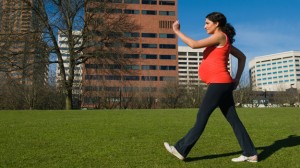
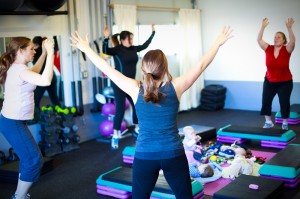
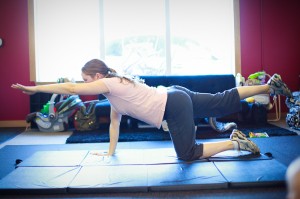
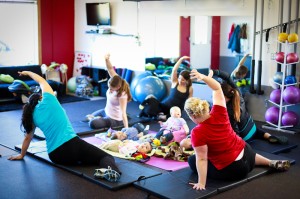
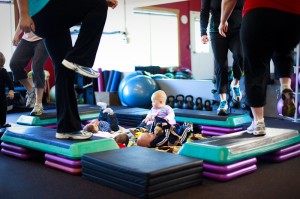
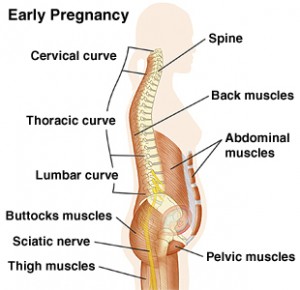


11 Responses to “Exercise During Pregnancy & The Role Of Physical Therapy”
Chenin Duclos
Dear Kmac,
Thank you for all your support during this project (and beyond). I really appreciate it. It was fun and I sure learned a lot. I’m discovering more and more that I really enjoy the health promotion aspects of PT – sharing info about our field, and educating about our role. I am often humbled by how little folks know about what we do – much room to provide education. Many folks just don’t know – and that is ok – it just leaves us with lots to talk about!
Be well.
Chenin
Chenin Duclos
Dear Stephanie,
Thank you dear for your compliments and taking the time to review my project. Priorities and other commitments are huge! Gjestald et al reported that as a top barrier to exercise during pregnancy.1 WBWC commented that the biggest barrier they come across in their practice is this exact topic as well– although my research suggested obstetric complaints were most significant. WBWC mentioned trying to come up with strategies in which women can attend to their priorities, yet incorporate exercise (for example, take stairs more often and park far away from the grocery store and other establishments). Make it fun and feasible. Many women enjoy exercise with a partner. PT’s can set up walking groups that meet daily at a certain time or even just hosting exercise classes specific to pre and post natal women might be more encouraging. Once the baby is born, being able to bring your baby to a class may really help too. Continuous Motion where my brother lives in Washington does just that -this way woman don’t have to worry about childcare.
I believe our influence is really about education. Many women seem to just not know what the benefits are, what to do, how much to do. Clarke et al and Duncombe et al both report that the most common source of information about exercise during pregnancy is from friends and family.2,3 This information is often inaccurate and sets up women for misconceptions about safety.2,3 Additionally, Clarke et al reports that <1/5 of women report receiving exercise advice from healthcare provider during pregnancy.3 PT’s are in the position to change that. We can start these conversations with our female patients even before pregnancy – emphasize importance and create good exercise habits early on.
Thank you again.
Chenin
References:
1. Gjestland K, Bo K, Owe KM, Eberhard-Gran M. Do pregnant women follow exercise guidelines? prevalence data among 3482 women, and prediction of low-back pain, pelvic girdle pain and depression. Br J Sports Med. 2013;47(8):515-520. doi: 10.1136/bjsports-2012-091344; 10.1136/bjsports-2012-091344.
2. Duncombe D, Wertheim EH, Skouteris H, Paxton SJ, Kelly L. Factors related to exercise over the course of pregnancy including women's beliefs about the safety of exercise during pregnancy. Midwifery. 2009;25(4):430-438. doi: S0266-6138(07)00045-9 [pii].
3. Clarke PE, Gross H. Women's behaviour, beliefs and information sources about physical exercise in pregnancy. Midwifery. 2004;20(2):133-141. doi: 10.1016/j.midw.2003.11.003 [doi].
Chenin Duclos
Dear Jason and Leah,
Thank you for your input and sharing story, Leah. Prior to presenting at WBWC, I inquired with them about how often they refer to PT and when (before or after delivery). The feedback I received was that they often refer after delivery for issues such as pelvic pain, incontinence and diastasis rectus abdominus. It didn’t seem like they refer during pregnancy as much, so not surprising that was your experience too. One of my objectives for the in-service was to raise awareness about the benefits of PT during pregnancy and the role of a PT at that time. The feedback I received after my presentation seemed to be that the providers at WBWC gained insight about how a PT can help during pregnancy and that in the future they feel comfortable referring. No discussion about chiropractic came up. Curious if you went Leah and how you are feeling.
I appreciate your suggestions about providing a website or another way to locate the women’s health specialist. I thought about doing that, but was stumped about who to put – triangle area PT’s? Move Forward APTA website is a great idea!
I have not read about physical therapy to facilitate turning the baby if breach/transverse; however, I do believe there is a place for PT in labor preparation and delivery. At CSM, I went to a great talk on the Emerging Role of PT in Labor and Delivery – presented by Janet Chamberlin, PT, WCS Susan A. Steffes, PT, CD(DONA). Think of the many preexisting MSK conditions that women may have before pregnancy (spinal fusion, hip/knee OA, spinal stenosis, coccyx dysfunction, etc.); these may challenge the biomechanics of their pelvis and low back during delivery, cause pain and impair the natural labor transitions. As Janet and Susan emphasized, PT’s are biomechanical specialists. In the future PT’s may be a welcomed component of a birthing team to support a labor and delivery. Stay tuned!
Chenin
Chenin Duclos
whoops…
Noelle – last reference
4. Chuntharapat S, Petpichetchian W, Hatthakit U. Yoga during pregnancy: Effects on maternal comfort, labor pain and birth outcomes. Complement Ther Clin Pract. 2008;14(2):105-115. doi: 10.1016/j.ctcp.2007.12.007; 10.1016/j.ctcp.2007.12.007.
Chenin Duclos
Dear Noelle,
So glad you enjoy the materials – it was fun to create and yes, the birth and wellness center seemed very excited and pleased to use the materials.
I didn’t come across any particular stretching guidelines, except to not overdo it or go to deep into a stretch. The ACOG does not address stretching in their guidelines.1 As we know, hormonal changes contribute to necessary ligament laxity during pregnancy; the pelvis needs to be able to widen to accommodate the fetus during birth. Certainly, some women are at greater risk for pelvic torsion and pain if they were lax before pregnancy and lacked muscular stability and control. I would say be gentle, perform stretches in symmetry, and seek guidance from an expert that can observe your stretching mechanics and ensure performance is appropriate and safe.
As far as yoga “contributing to pelvic torsion and pain” – my thoughts on that are many things can contribute: yoga, lack of yoga , exercise, lack of exercise, prepregnancy MSK concerns, biomechanical abnormalities, poor ergonomics, weakness, etc. I have a little soap box here – often I feel disappointed that many people only associate yoga with stretching (not that you are), but yoga is about stabilizing, control and strength just as much… if not more! “It has been recommended that specific exercise incorporating local and global stabilizers and tailored according to an individual’s needs will have the most impact” on low back and pelvic pain during pregnancy (prevention and decreasing intensity).2 Yoga is perfectly suitable to be the format for this type of exercise – one just needs a skilled teacher. You are correct – without guidance, yoga could potentially negatively impact pelvic torsion and pain. Thing is, it is not so much yoga as it is just incorrect performance of exercises. Yoga, walking, Pilates, PT, dancing – many things can contribute if performance is poor and not adapted for the individual.
As far as poses to avoid –if a woman is going to attend a yoga class, it is helpful to go to one specific to pre- and postnatal. These teachers can offer the necessary guidance and supervision. Women want to avoid poses that require prolonged supine position after the first trimester; this puts too much pressure on the vena cava and is thought to interfere with cardiac output.1 “Ligamentous laxity, weight gain, and lumbar hyperlordosis may contribute to the low back and pelvic girdle pain that is so prevalent in this population.”2 When I taught, I avoided poses that encouraged extension in the lumbar spine, since often women are hyperlordic during pregnancy. For example, when on hands and knees performing cat/cow (flexion/extension), I would just have pregnant women do the flexion part then come to neutral. Of course there are many opinions on what to avoid or use caution with, it also really depends on your prepregnancy activity and familiarity. I used to attend yoga classes in which this woman (very advanced yoga practitioner for YEARS) would be doing headstands while very far along in her pregnancy. Of course I think inversions are not for everyone, but I wonder if they were ok for her since she was doing them every day for years and all through her pregnancy. Not sure the research exists and there are many factors to consider. I recommend checking with your healthcare team for more specifics to your unique body.
Yoga during pregnancy has been shown to reduce physical pain, decrease depression, stress and anxiety, and improve maternal comfort and labor experience.3,4 So many great benefits, just perform with guidance from skilled PT or yoga teacher.
Thanks Noelle.
References:
1. Committee on Obstetric Practice. ACOG committee opinion. exercise during pregnancy and the postpartum period. number 267, January 2002. american college of obstetricians and gynecologists. Int J Gynaecol Obstet. 2002;77(1):79-81.
2. Lillios S, Young J. The effects of core and lower extremity strengthening on pregnancy-related low back and pelvic girdle pain: A systematic review. Journal of Women’s Health Physical Therapy. 2012;36(3):116-124.
3. Beddoe AE, Paul Yang CP, Kennedy HP, Weiss SJ, Lee KA. The effects of mindfulness-based yoga during pregnancy on maternal psychological and physical distress. J Obstet Gynecol Neonatal Nurs. 2009;38(3):310-319. doi: 10.1111/j.1552-6909.2009.01023.x; 10.1111/j.1552-6909.2009.01023.x.
Chenin Duclos
Dear Lauren,
Thank you for your feedback and sharing that story. I chuckled about the gene comment . Yes, some women and men are not “blessed” with the “stay-fit-during-while-a-human gene”, regardless exercise is important. I am proud of that woman for learning from her first pregnancy and working hard to make her second more comfortable and enjoyable. Some of the great benefits of pre- and postnatal exercise are maintaining a healthy weight during pregnancy and returning to a healthy weight after delivery.1,2 Barakat et al performed several studies; many of which I referenced in my presentation for the wellness center. These authors report that excessive weight gain during pregnancy correlates with retention of weight after pregnancy.1 Good news is, participants in these studies who exercised during pregnancy (in accordance to the recommended guidelines) often gained less weight during pregnancy, yet still within the necessary amount.1,2 There ya go! Additionally, mothers had a reduced risk of having a baby with macrosomia (baby gaining too much weight in utero).2 Fetal macrosomia often occurs as a complication of gestational diabetes (risk if GDM can be reduced by exercise) and has been associated with maternal and neonatal morbidity.2 Fetal macrosomia can lead to obesity and higher risk of cardiovascular and metabolic complications in adulthood2 – something parents of course don’t want for their children. Keeping fit during pregnancy is hard work, but quite important. As you mentioned patient education is vital. Thanks again for your input and enjoy these resources.
Chenin
References
1. Barakat R, Pelaez M, Montejo R, Luaces M, Zakynthinaki M. Exercise during pregnancy improves maternal health perception: A randomized controlled trial. Am J Obstet Gynecol. 2011;204(5):402.e1-402.e7. doi: 10.1016/j.ajog.2011.01.043; 10.1016/j.ajog.2011.01.043.
2. Barakat R, Cordero Y, Coteron J, Luaces M, Montejo R. Exercise during pregnancy improves maternal glucose screen at 24-28 weeks: A randomised controlled trial. Br J Sports Med. 2012;46(9):656-661. doi: 10.1136/bjsports-2011-090009; 10.1136/bjsports-2011-090009.
Karen
Chenin, The work you did on the project is super and I love how you’ve organized it here. You have such a nice way of “telling a story” in your writing. That will continue to serve you well as you transition to PT-hood 🙂
The brochure and handout looks very professional – you have quite a design eye in addition. I’m glad that you were able to get collaboration with the WH therapists at UNC and with the WBWC – sounds like they needed some education about what PT can offer based on Jason’s comment!
kmac
Stephanie Lawson
Hi Chenin!
Great work! Everything you did is wonderful! What a great brochure for pregnant women! You gave such great information and for such a range of people. Often women do not know where to start, but what great ideas you gave them. It was easy to relate to and I would know exactly where to start.
I was very impressed with your presentation as well. It’s such an important topic and I’m glad you shared it.
I think of a lady I work out with here at home in our group exercise classes. She’s taken a lot of precautions during pregnancy and knew the rules about not lying on her back after the first trimester. However, she experienced more shortness of breath than normal. I haven’t seen her in awhile, but I think she is exercising some but not near as much as she used to. I wonder too if priorities already start changing for pregnant women? How can we influence them how important it still is? You have done a great job so far and your brochure is something I will be saving to hand out as well! (As long as that’s okay!)
Wonderful job, Chenin. I love Women’s Health PT and so glad you share this love as well. This information is so important and glad you want to share it!
Stephanie
Jason Albright
Chenin,
I have to give you another WOW! Leah and I are very impressed with your capstone. I wanted to share with you about our experience at the WBWC. Leah recently went in to the WBWC because she was having pain in the pubic symphysis region. Much to my surprise they referred her to a chiropractor, with no mention of physical therapy. I’m really glad to see that you took the time and energy to educate the WBWC and provide handouts that they can give to expecting mothers. Your capstone is definitely going to make a difference in expecting mother’s lives, and it’s definitely going to help physical therapy as a whole been seen from a whole new perspective in the publics eye.
One suggestion I have on the handout and brochure, which I think are very well done by the way, is to provide a website or another way to locate the women’s health specialist. I was thinking listing the Move Forward APTA website would allow interested mothers to access a list of all the women’s health specialists in their area.
I am also interested to see what you think about how PT’s can be utilized in the scenarios of a transverse or breached baby. I know from personal experience that there are more conservative ways of turning babies in utero through positioning. I also know that the WBWC will refer mothers in this situation to MD’s and/or Chriopractors to perform certain manipulations of hips or actual hands on turning of the breached or transverse baby. Did you come across any evidence pertaining to the use of PT’s in this manner, or in your experience do you think women’s health specialist can be utilized for breached babies?
Great work on this capstone.
Jason
Noelle Martin
Chenin,
Great project! I absolutely love the handout you created! It looks very professional, fun, and informative! I am sure the patients and the practice will also find it wonderful! I have already learned a host of information from reviewing your products. This is such a great and unique topic and I can feel your enthusiasm throughout it. Thanks for advocating for the profession of PT and for women’s health!
I’m intrigued to learn more and have a few questions for you. Did you come across any particular stretching guidelines or dos and don’ts for stretching throughout and/or after pregnancy? I have heard that yoga can contribute to pelvic torsion and pain. Based on your research and interactions, do you think this is an issue for pregnant women? Should certain yoga poses be avoided during pregnancy?
Great job!
Noelle
Lauren Diamond
Chenin,
Wow, what a wonderful capstone!! I was so excited to read more about your research and experiences. Not only does my excitement come from interest in physical therapy and the active population (assuming that many of my patients will become or have recently been pregnant) but also for my own education. I recently was out running errands when I heard two women talking and one shared that she was due in two weeks. I will admit, this lady was in incredible shape and had done a fabulous job with nutrition and exercise… or maybe she was just blessed. She continued on to say that she in fact had to be mindful and was not so “blessed” with the stay-fit-during-while-a-human gene. She went on to explain that she had gained a significant amount of weight in her first pregnancy and it was an overall poor experience. This woman had learned through experience, but how great that we as physical therapists can work with other healthcare providers to educate these women BEFORE they have to learn the hard way. Your brochure is so nicely laid out and great job with health literacy! It had such a nice flow and I think it really educated women on what to do, when to do it, and what to do if x, y, or z happens.
You’ve created a remarkable tool and I’m sure I will be looking to you for advice or permission to share some of these great resources!
Also I think I recognize a baby star in this brochure!! Oscar is famous!
Great job!
Lauren